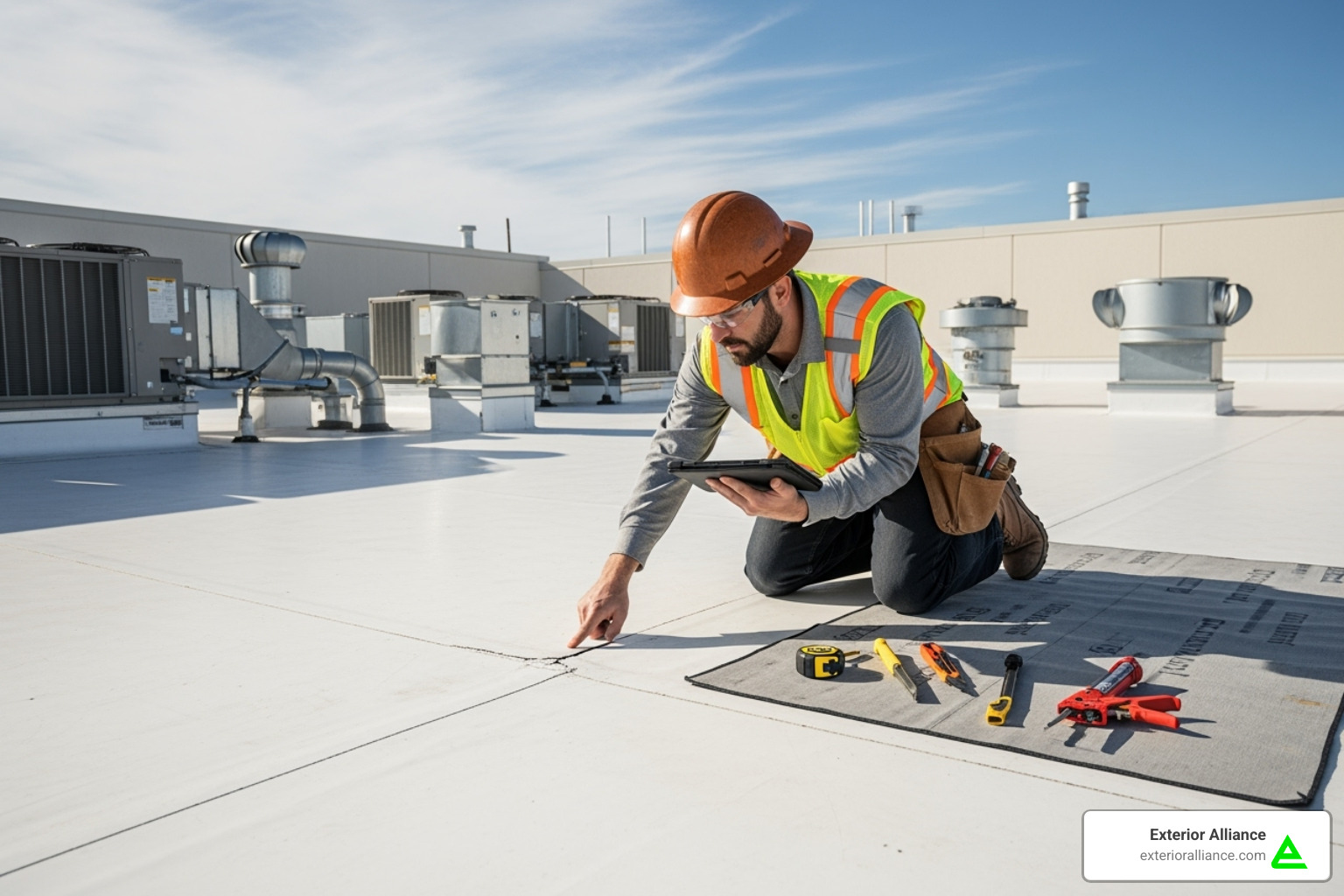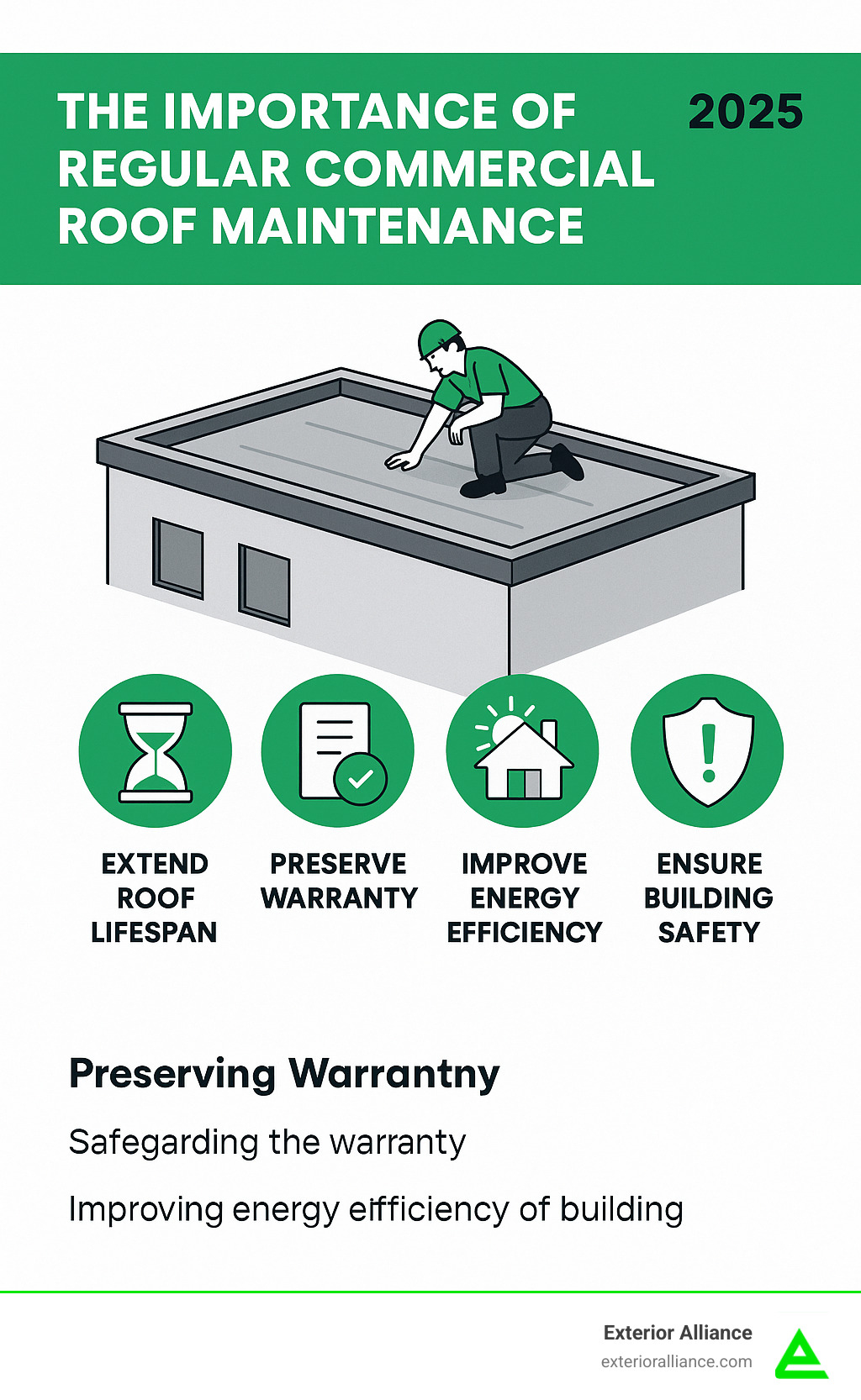Protecting Your Business Investment
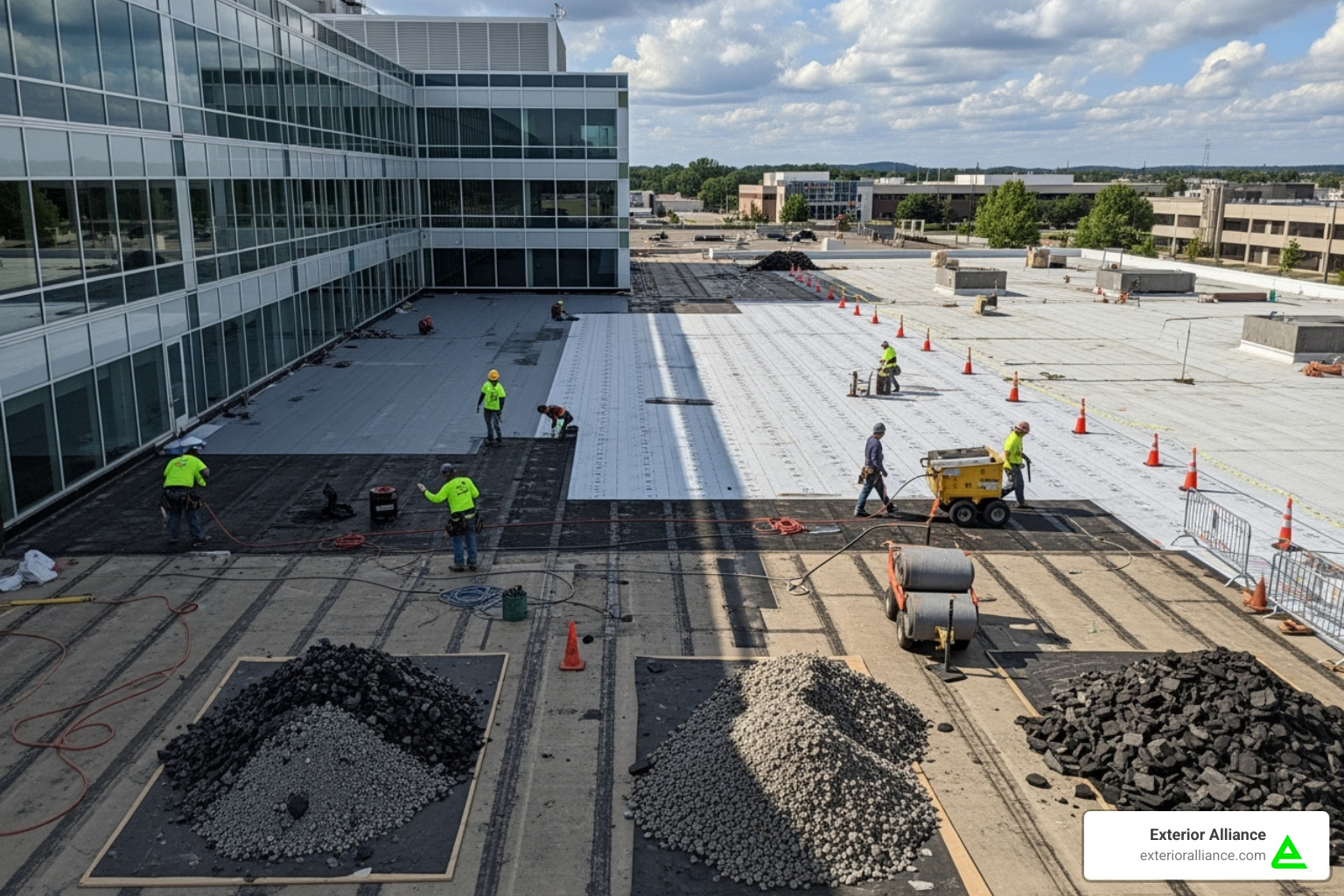
A commercial roof replacement is a significant investment, but it’s essential for protecting your business operations and property. Most commercial roofs last 20-30 years; when that time comes, a replacement becomes critical for maintaining safety, energy efficiency, and property value. For property owners in Columbus and throughout Ohio, severe weather like hailstorms can accelerate this timeline, making it crucial to recognize the signs of failure.
Key signs you need a commercial roof replacement:
- Age: The roof is over 20 years old.
- Frequent Leaks: You require constant repairs for recurring leaks.
- Visible Damage: You notice cracking, blistering, sagging, or ponding water.
- Rising Energy Bills: Poor insulation from a failing roof increases heating and cooling costs.
- Storm Damage: A single storm damages more than 25% of the roof surface.
A typical replacement takes 7-14 days, and the investment pays off through improved energy efficiency, better protection from weather, increased property value, and comprehensive warranty coverage.
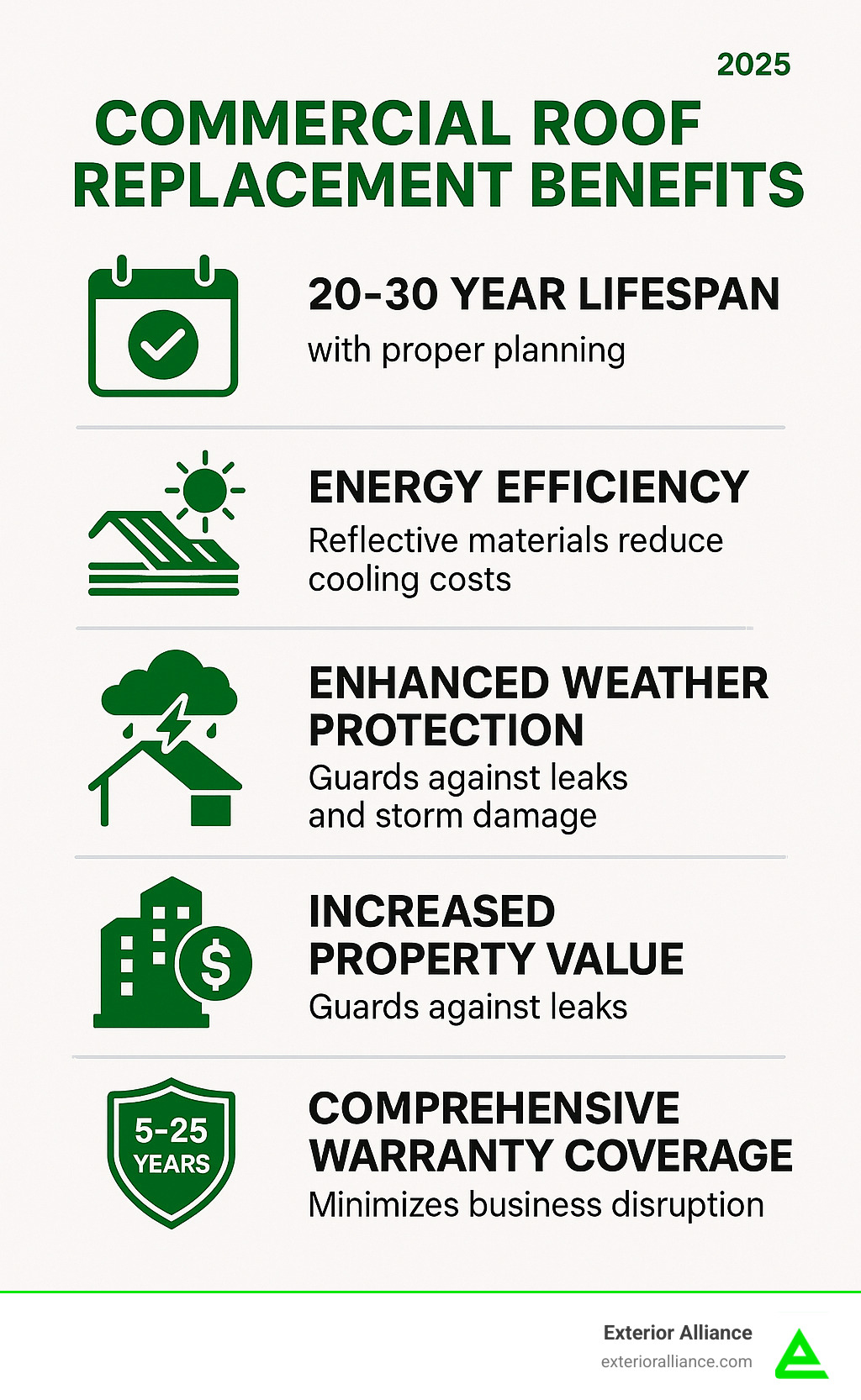
The Complete Commercial Roof Replacement Process from Start to Finish
When it comes to your commercial property, the roof isn’t just a cover; it’s a critical component of your business’s infrastructure. It protects your assets, employees, and operations from the elements. This section covers everything a property owner needs to know, from identifying the need for a new roof to selecting the right team for the job.
Key Indicators: When to Replace vs. Repair
Knowing when to repair versus committing to a full commercial roof replacement is a critical decision. While minor repairs can seem cost-effective, persistent problems often signal that your roof is at the end of its functional life.
The most common indicators include:
- Frequent Leaks: If you are constantly calling for repairs to fix leaks or water stains, it’s a clear sign the roofing system’s integrity is compromised. Patching is no longer a sufficient solution.
- Roof Age: Most commercial roofs last 20-30 years. If your roof is approaching or has passed this age, a proactive commercial roof replacement is a wise consideration, even without obvious issues.
- Visible Damage: Look for cracking, blistering, sagging areas, or damaged membrane sections. A sagging roof deck is especially dangerous as it points to structural problems.
- Rising Energy Bills: A deteriorating roof loses its insulating properties, causing your HVAC system to work harder and increasing your utility costs.
- Significant Storm Damage: Ohio’s weather can cause widespread damage. If a storm compromises more than 25% of your roof, or if issues persist after repairs, a full replacement is often the most economical and safest long-term choice. While some issues can be fixed with targeted Commercial Flat Roof Repair, knowing when to invest in a complete overhaul saves money and prevents future disruptions.
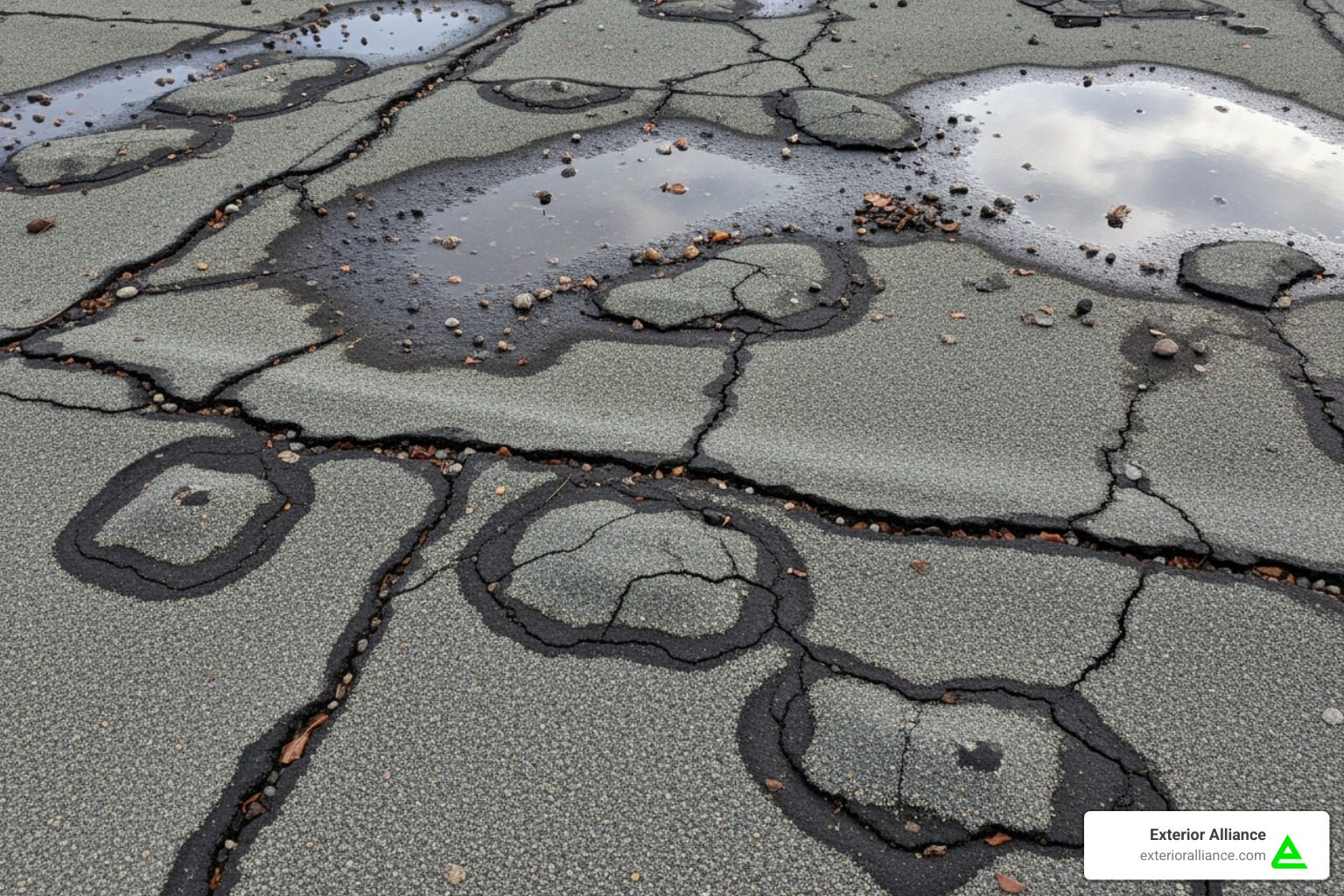
Planning Your Project: Timelines, Materials, and Business Continuity
Once a commercial roof replacement is deemed necessary, careful planning is key to a smooth project with minimal disruption. A typical replacement takes 7-14 days, but the timeline can be affected by roof size, complexity, underlying damage, and weather.
We prioritize your business continuity by creating a detailed project plan. This may involve phased work, scheduling noisy activities during off-hours, and maintaining a clean, safe site to minimize impact on your employees and customers. For seasonal insights, see our guide on Roofing Winter Preparation for Commercial Buildings.
Choosing the right material is crucial. Common options include:
- TPO (Thermoplastic Polyolefin): An energy-efficient and reflective single-ply membrane.
- EPDM (Ethylene Propylene Diene Monomer): A durable and cost-effective synthetic rubber membrane.
- Metal Roofing: Offers exceptional longevity and resistance to wind and hail.
- Modified Bitumen: A durable, flexible system applied in multiple layers.
Advanced options like Duro-Last’s prefabricated systems can reduce on-site installation time and improve quality by having up to 85% of seams completed in a factory. Safety is always our top priority, and we adhere to all National Roofing Contractor Association (NRCA) standards, avoiding risky installation methods to protect your property and its occupants.
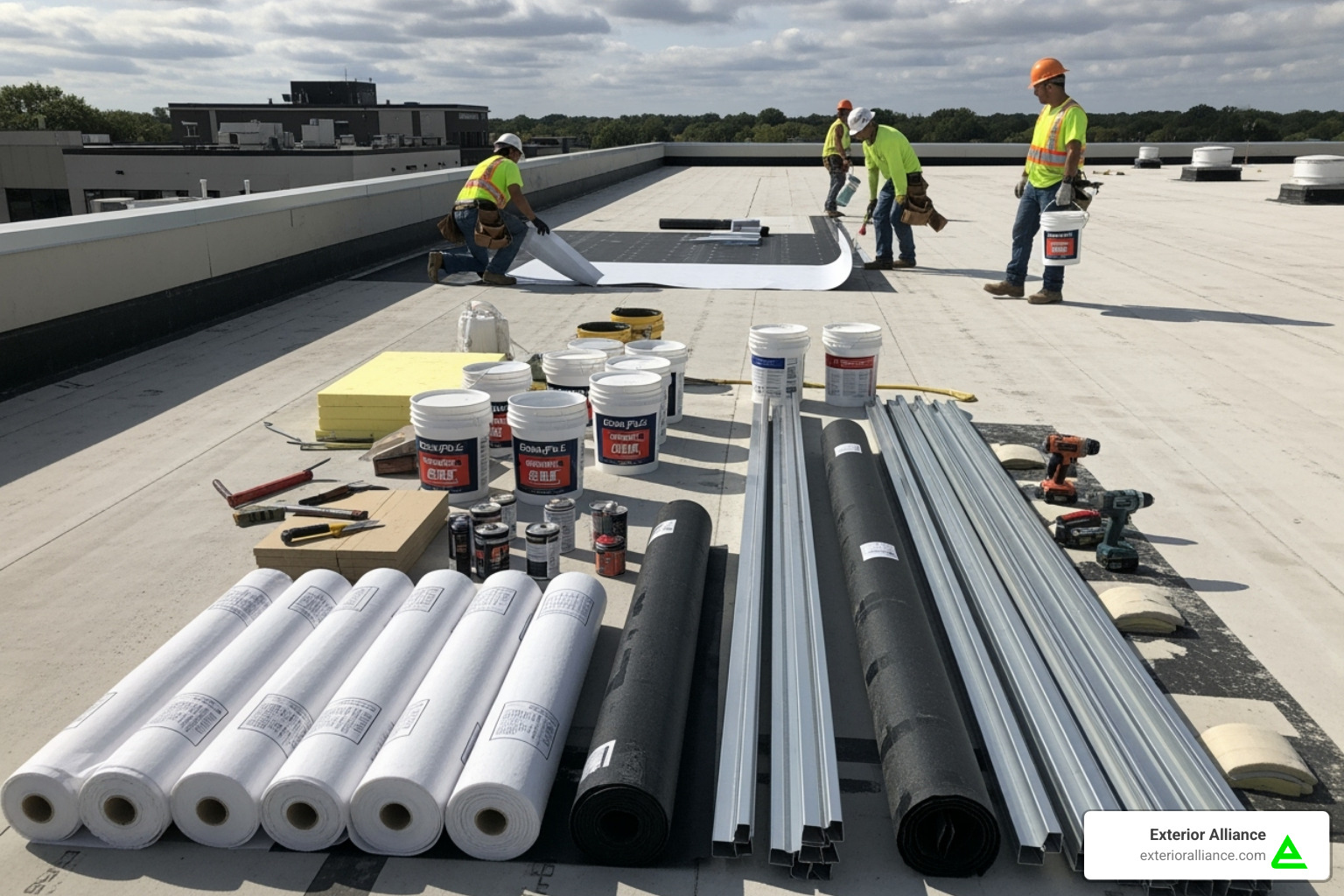
Understanding the Costs and Long-Term Benefits of a Commercial Roof Replacement
A commercial roof replacement is a major investment that delivers substantial long-term returns. The final cost depends on several factors, including the material chosen, roof size and complexity, accessibility, and local labor rates. For a detailed breakdown, see our Roof Replacement Cost page.
Average costs per square foot for common materials:
- Single-Ply (TPO, EPDM): $3.50 – $7.50
- Metal Roof: $5.00 – $12.00
- Modified Bitumen: $6.90 – $17.25
While the upfront cost is significant, the long-term benefits are compelling:
- Improved Energy Efficiency: Modern reflective materials can dramatically lower cooling costs.
- Superior Protection: A new roof safeguards your assets, inventory, and building structure from costly water damage.
- Increased Property Value: A new, high-quality roof is a major asset that improves your property’s market value.
- Longevity and Warranty: A professionally installed roof can last 20-30 years and comes with comprehensive manufacturer and workmanship warranties, providing peace of mind. For example, some premium warranties like those from Duro-Last even cover issues like ponding water, which are often excluded by others.
- Fewer Business Disruptions: A reliable new roof eliminates the stress and cost of unexpected leaks and emergency repairs.
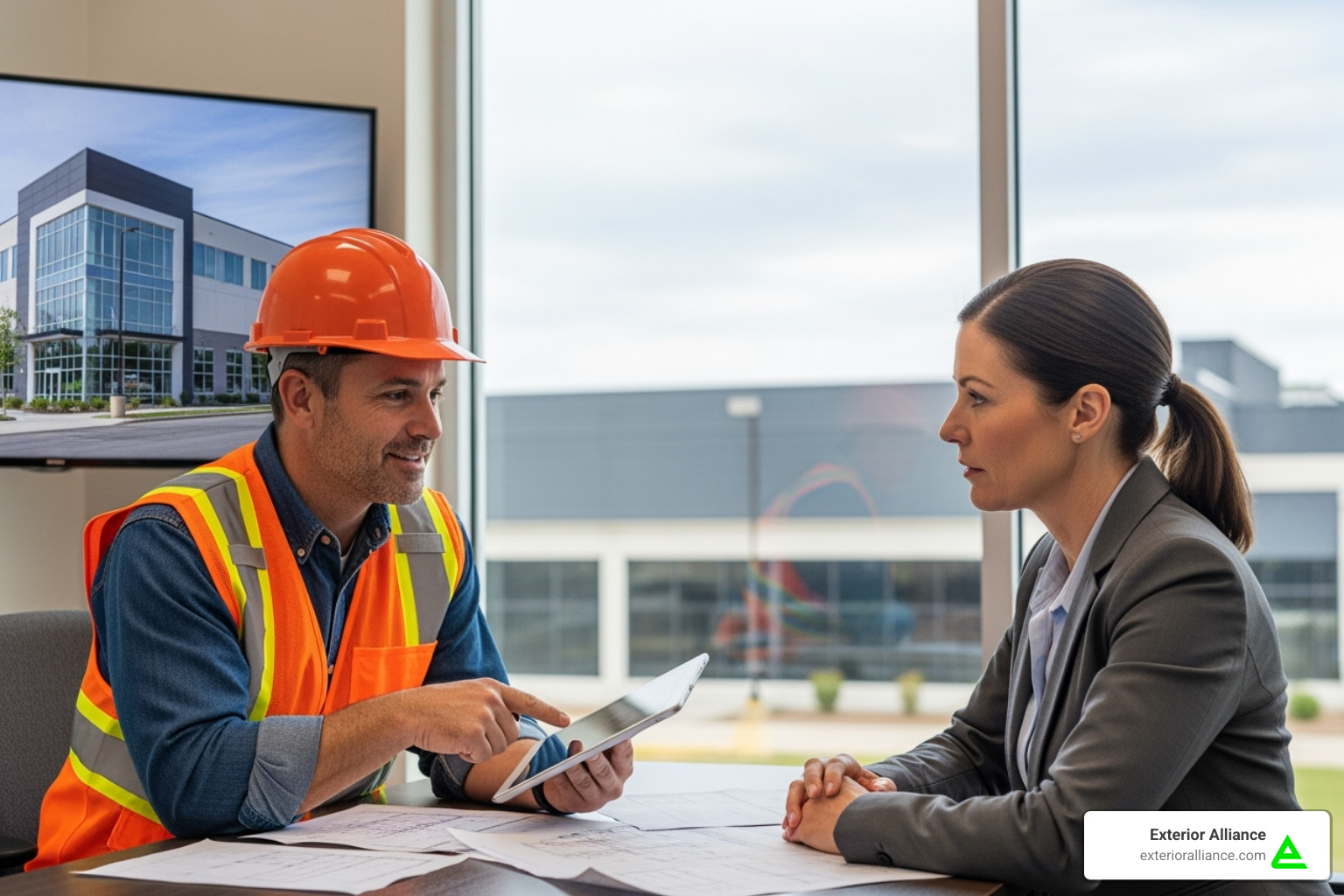
Navigating Insurance Claims and Building Codes
For many property owners in Ohio, a commercial roof replacement follows a severe weather event, making insurance navigation a key part of the process. Ohio’s hailstorms and high winds cause significant damage, so it’s important to understand your insurance policy.
When filing a claim, be sure to thoroughly document all damage with photos and a detailed report from a qualified roofing contractor like Exterior Alliance. Be aware of your policy’s terms regarding depreciation, as insurance companies may only cover the actual cash value of an older roof, not the full replacement cost.
It’s also vital to have code upgrade coverage. Local building codes change over time, and your new roof may be required to meet stricter standards for wind resistance or insulation. Without this coverage, you could face significant out-of-pocket expenses. Our team is experienced in working with insurance providers and can help you steer your claim. For more information, visit our Storm Damage Roofing Ohio page and see the Hail damage information from the Insurance Information Institute.
We are well-versed in the building codes throughout Central Ohio and Cincinnati and will handle all necessary permits to ensure your new roof is fully compliant, protecting you from future legal or insurance issues.
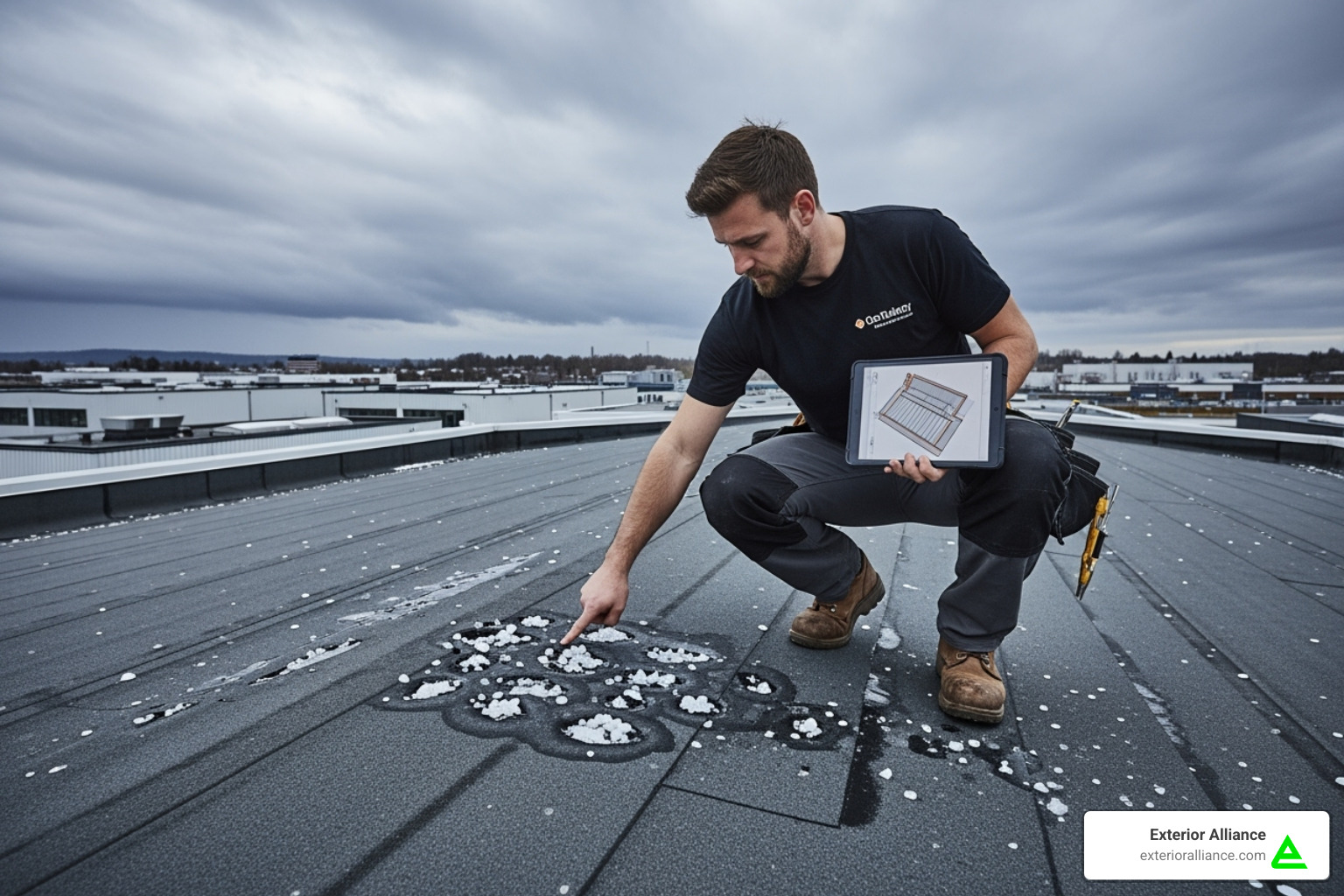
How to Choose the Right Contractor for Your Commercial Roof Replacement
Selecting the right contractor is the most critical decision for your commercial roof replacement. The quality of the installation determines the longevity and performance of your new roof.
Look for a contractor with these key qualifications:
- Licensing and Insurance: Verify the contractor is fully licensed and carries comprehensive liability and worker’s compensation insurance. This protects you from liability. Exterior Alliance is a fully insured general contractor.
- Local Experience and Storm Damage Expertise: Choose a contractor with a proven track record in Central Ohio. They will understand local building codes and weather challenges, especially hail and wind damage, and can effectively manage insurance claims.
- Manufacturer Certifications: Certifications from top manufacturers like GAF, Owens Corning, or CertainTeed indicate a high level of training and allow the contractor to offer improved warranties.
- Strong Warranties: A trustworthy contractor will stand behind their work with a solid workmanship warranty in addition to the manufacturer’s material warranty. We provide a five-year workmanship warranty.
- Positive Reputation: Check online reviews, ask for references from past commercial clients, and look for a contractor with a long-standing, positive presence in the community and a high BBB rating.
- Clear Communication: A professional provides a detailed, written estimate and maintains open communication throughout the project.
Choosing the right contractor means finding a partner you can trust to protect your investment. To help your search, check out our guide on How to Find the Best Commercial Roofing Contractor in ColOhio.
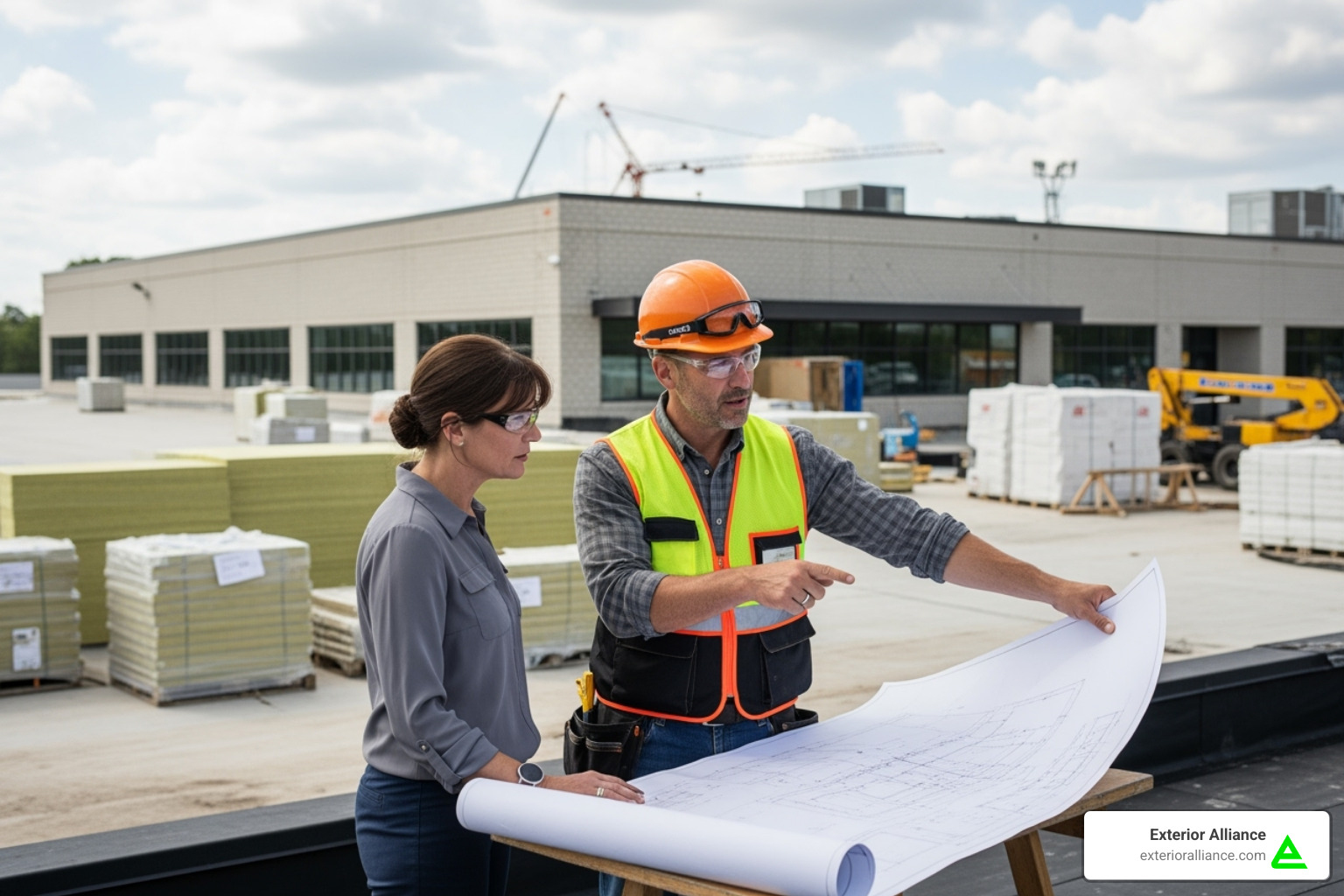
Securing Your Asset for the Future
Your commercial roof replacement is complete, but protecting your investment is an ongoing process. Proper care and maintenance are key to ensuring your new roof delivers decades of reliable performance and reaches its maximum lifespan.
Final Steps and Maintaining Your New Roof
As your project concludes, we conduct a comprehensive final walkthrough with you to ensure every detail meets your expectations. This is when we answer all your questions and provide you with the warranty information for your new roof. These warranties, which typically cover both materials and workmanship for 5 to 25 years, are your guide to protecting this major investment.
To get the most out of your new roof, a simple preventative maintenance plan is essential. Regular care helps prevent small issues from becoming costly problems and keeps your warranty valid.
Key Maintenance Tips:
- Regular Inspections: Have your roof professionally inspected twice a year (spring and fall) and after any major storm.
- Keep Drains and Gutters Clear: Clogged drainage systems can cause water to back up, leading to damage to the roof and your building’s foundation.
- Remove Debris: Promptly remove leaves, branches, and other debris that can trap moisture and degrade roofing materials.
- Address Ponding Water: While some warranties cover it, standing water that remains for more than 48 hours indicates a drainage issue that should be addressed.
- Protect from Foot Traffic: Use designated walk pads around HVAC units and other rooftop equipment to prevent damage to the roof membrane during servicing.
At Exterior Alliance, we are your long-term roofing partner. Our expertise in the Dublin and Central Ohio area means we understand what your roof needs to withstand our changing seasons. For more detailed guidance, see our Flat Roof Inspection Checklist. and learn more about our Commercial Roofing Services.
